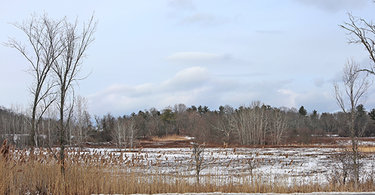Town updates solar law to allow more facilities while protecting farmland, forests
NEW SCOTLAND — Over the course of 80 minutes at its recent monthly meeting, the New Scotland Town Board accomplished much but left more to be done.
The town board on Feb. 8 signed off on updates to New Scotland’s solar law, property annexations, and a couple of projects. But the board debated funding sources for other projects and proposals, and tax breaks for first responders, and then went into executive session to discuss a new revenue stream for the town.
Solar projects in New Scotland have been highly scrutinized since the town adopted its solar law in 2017, in part because of the way the law, which was largely based on a state model, was written.
The law states no large-scale projects are permitted on:
— Land that has prime soils, defined as “land that has the best combination of physical and chemical characteristics for producing food, feed, forage, fiber, and oilseed crops and that is available for these uses.”
The update to the 2017 law narrows the prime-soils definition to “Active Agricultural Land,” which is land greater than seven acres that within the last five years of the date the application is filed for a large solar facility was used for agriculture. Agricultural uses include, but are not limited to, the production of crops, hay, livestock and livestock products;
— Land that has soils of statewide importance, “where less than 50 percent of the components in the [area] are prime but a combination of lands of prime or statewide importance is 50 percent or more of the [area] composition.”
The basic idea is to protect the town’s actual usable farmland, and not have a “blanket prohibition,” Councilman Dan Leinung previously told The Enterprise. “So we’re trying to narrow it down or focus it more on the actual use of the agricultural land,” he said; or
— Land that has more than an acre of mature forest, which contains trees that are predominantly six inches in diameter or more.
“We’ve found though, with the mature forest, that someone could come in and clear-cut it in anticipation of a year later bringing in solar,” Supervisor Douglas LaGrange said on Feb. 8. “So we’re losing — we could potentially lose a lot of trees to gain solar, when we have a lot of marginal land throughout the town that would suffice for solar.”
The new law allows for a five-year lookback window, meaning that the land’s use will be examined for the past five years if an applicant is looking to change its use.
The new law says if land has had an agricultural use in the past five years it isn’t qualified for solar, which was the same thing the old law did with prime soils.
“You have to come in and ask for a variance. It’s a similar thing,” Leinung previously explained. “It’s generally a prohibition, but you can always come into the board and they can make their determination on a case-by-case basis about that.”
Projects and paying for them
The board passed a project resolution approving emergency interconnection between the Northeast and Kensington water districts.
Three years ago, customers in the Northeast Water District were buying their water from the village of Voorheesville after the town had to take the district offline following an unusually high master meter reading. The source of the high reading — a 4,000-gallon-an-hour leak — was a 3-foot long vertical crack in the district’s 25-year-old underground 18,000-gallon fiberglass tank.
The town paid $12,500 to fix the crack in the tank, and paid engineers Barton and Loguidice thousands more to come up with a solution for future outages.
On Feb. 8, board members approved a bond resolution not to exceed $180,000.
About $52,000 is allocated for the emergency interconnection between the two water districts, covering the purchase of pipe and other materials with the understanding that labor would be provided by the town’s department of public works.
The remaining funds are earmarked for projects at the Hilton Barn.
Earlier in the meeting, the board put off a vote on bonds to fund upgrades to the pumps in the Swift Road Water District, an amount not to exceed $40,000, and the purchase of an excavator for the highway department, an amount not to exceed $180,000.
The discussion revolved around whether it was more cost-effective for the town, with its healthy rainy-day fund, to pay for the equipment outright or to bond the purchases and possibly pay high interest rates on its loans.
The board ultimately decided to table the vote on the bonds and get more information about paying for the equipment with money in the bank.
The Feb. 8 meeting ended with board members entering into executive session to discuss a proposal from Verizon Wireless to lease land at the town-owned Kensington Woods water tower site.
The 36-acre parcel is located on Fairfax Boulevard in the Kensington Woods subdivision. The initial term of the agreement is for 5 years beginning on a date yet to be determined.
The town would receive $10,800 in annual rent from Verizon, according to the proposed contract.
New village properties
Over a year ago, the town received a petition for the annexation of territory from New Scotland to the village of Voorheesville.
Some homes along West Street were “struggling with water… And the only way that they can get water financially is to be a part of the village, and the village will run the main and provide it,” LaGrange said in January 2022, adding that the village already plowed West Street for the town.
On Feb. 8, eight New Scotland parcels became part of Voorheesville: 36 West St., 39 West St., 41 West St., 44 West St., 50 West St., and 51 West St., along with two addressless portions of West Street.
Tax breaks
Like other taxing jurisdictions, the town of New Scotland is now deciding whether or not to offer a property tax break to volunteer firefighters and ambulance workers.
Last year, Governor Kathy Hochul signed into law a bill that allows counties, cities, towns, villages, and school districts to offer a property tax break to its volunteer first-responders. The state legislation enables the taxing jurisdictions to provide up to a 10-percent exemption for a period of between two and five years for volunteer first responders whose primary residence is located in the jurisdiction.
Taxing jurisdictions have until March 1, what board members described as the taxable status date, to vote on the exemption. “Although there are a lot of rumors flying around that that March 1 deadline could get extended,” said Councilman Adam Greenberg during the Feb. 8 meeting.
The issue with the state law is its ambiguity because it says each taxing jurisdiction has to set up the procedure by which eligibility will be determined.
Supervisor LaGrange said he spoke to Mike McGuire, who used to be New Scotland’s assessor but now works for Albany County, who recommended “that we get our ducks in order, [and] see what the county uses for a definition of an active member.”
Onesquethaw and New Salem, which cover the majority of New Scotland save for the village of Voorheesville and small portions of the northeastern part of town in the North Bethlehem and Slingerlands fire districts, use Length of Service Award Programs (LOSAP), which is based on a point system of activities performed by volunteer first-responders.
The county can’t use LOSAP as a member determinant, LaGrange said, “because there’s a lot of firehouses and ambulance districts that do not use [LOSAP]. So they’re trying to come up with a definition to address what is an active member.”
The county made an announcement on Feb. 6 that it would be offering volunteer first-responders a 10-percent break on their county property taxes, but did not offer details on what it considered an active volunteer. There are over 30 volunteer fire departments in Albany County.
Discussing the financial impact of a 10-percent exemption, LaGrange said volunteers could take either a $200 credit on their state income taxes or, using the example of a home located in the Onesquethaw Fire District assessed at $175,000, the first-responder could receive a $57 property-tax break
“I mean, that’s obviously a no-brainer,” LaGrange said of which tax break to take.
He then said more than one exemption could apply if there were more than one volunteer in a household
“According to Mike McGuire, the people in the house can take this exemption if they’re both active firefighters or ambulance folks,” LaGrange said. “So even still, $114 or $400, you know, they’re always going to take, obviously, the 400.”
All board members were generally supportive of the proposal but also acknowledged they needed more information, and decided to hold a special meeting on Feb. 22 to discuss the issue further; the meeting itself has since been canceled.



